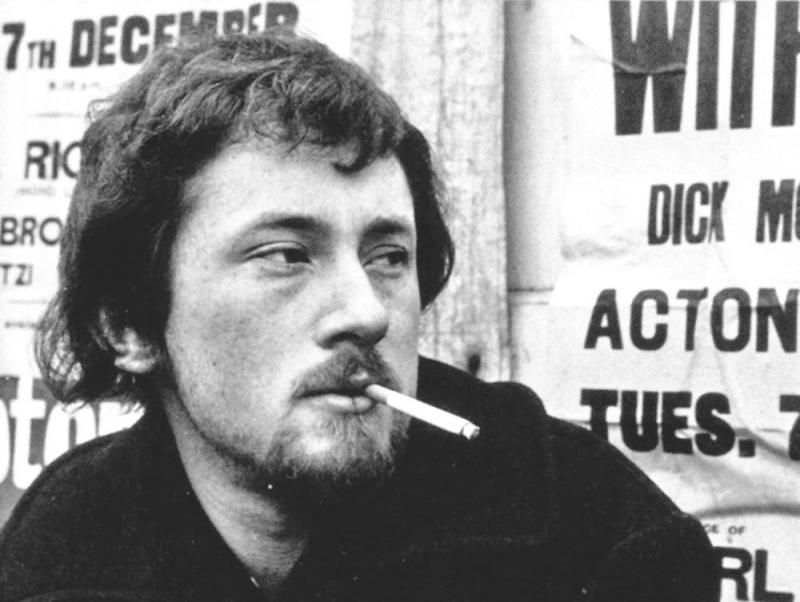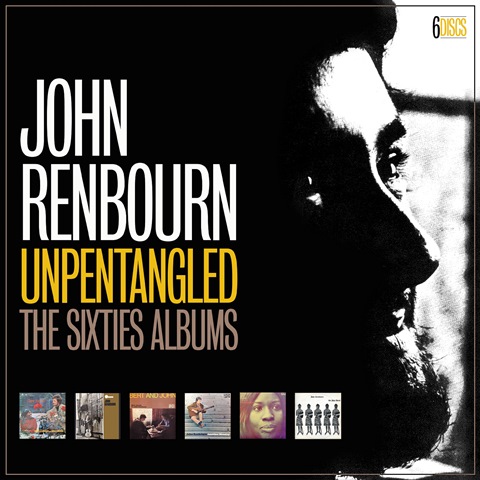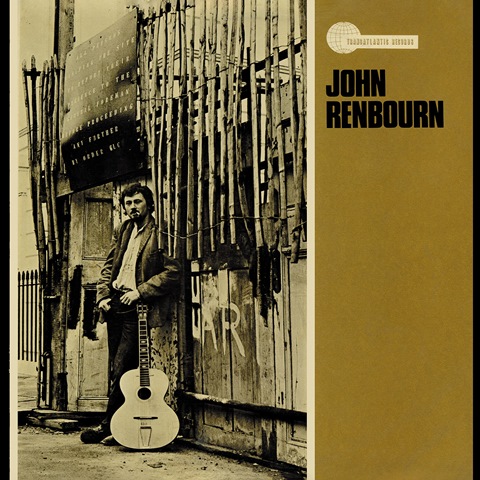Reissue CDs Weekly: John Renbourn | reviews, news & interviews
Reissue CDs Weekly: John Renbourn
Reissue CDs Weekly: John Renbourn
The ‘Unpentangled’ box set captures the great guitarist's pre-Pentangle magpie-mindedness

Although British folk-jazz stylists Pentangle played their first official concert in May 1967, their name is borrowed for the title of Unpentangled, a box set of their guitarist John Renbourn’s work on album which kicks off two years earlier.
In tracking back, Unpentangled makes it clear that Pentangle coalesced rather than formed. After listening, what’s also apparent is how tangled a trail Renbourn, who died in 2015, charted before his absorption into Pentangle.
 The six albums collected in this clamshell box set are Dorris Henderson & John Renbourn’s There You Go! (issued in February 1966), John Renbourn (March 1966), Bert Jansch & John Renbourn’s Bert And John (September 1966), Another Monday (November 1966), Dorris Henderson’s Watch The Stars (February 1967) and Sir John Alot Of Merrie Nglandes Musyk Thyng & Ye Grene Knyghte (June 1968), released after Pentangle had formed. Excepting Another Monday, each includes bonus tracks: either alternate versions unissued at the time or non-album single sides.
The six albums collected in this clamshell box set are Dorris Henderson & John Renbourn’s There You Go! (issued in February 1966), John Renbourn (March 1966), Bert Jansch & John Renbourn’s Bert And John (September 1966), Another Monday (November 1966), Dorris Henderson’s Watch The Stars (February 1967) and Sir John Alot Of Merrie Nglandes Musyk Thyng & Ye Grene Knyghte (June 1968), released after Pentangle had formed. Excepting Another Monday, each includes bonus tracks: either alternate versions unissued at the time or non-album single sides.
As the artist credits confirm, not all were solo sets. One was not even conceived as an album. There You Go! found Renbourn accompanying the transplanted American singer Dorris Henderson; John Renbourn collected studio demos recorded during late 1965 without their release in mind, and Bert And John was a collaboration between to two titular players. The fourth album here, Another Monday, was Renbourn’s first as-such solo outing. While this suggests Renbourn was happy as an accompanist and maybe fine with not taking a front-line credit, it’s also a valuable reminder that bigger pictures can lie beneath the surface.
There You Go!, the earliest album, is a product of its time – Renbourn said it was an accurate record of his and Henderson’s club act of the period. Traditional folk material like “Sally Free and Easy” is heard alongside blues and an uncomfortable, presumably audience-satisfying, version of “Mr Tambourine Man”. Renbourn’s dextrous guitar shows he took stylistic shifts in his stride. As a time-capsule artefact, There You Go! fascinates but at this remove Henderson’s theatricality and tendency to oversing dominates, making for an album which hasn’t worn well.
 Although solo and taped before There You Go!, John Renbourn is another snapshot of what was played live and again demonstrates versatility. A track not originally issued on the album is a version of Jackson C Frank’s “Blues Run the Game”, proof of an acute awareness of what was going on in the clubs.
Although solo and taped before There You Go!, John Renbourn is another snapshot of what was played live and again demonstrates versatility. A track not originally issued on the album is a version of Jackson C Frank’s “Blues Run the Game”, proof of an acute awareness of what was going on in the clubs.
Bert and John similarly evinces a hop-scotch outlook as it roams even more widely than the preceding albums: Charles Mingus’ “Goodbye Pork Pie Hat” is tackled. While rootsy, all three albums are square pegs which don’t fit the folk hole.
By the time of Bert and John, it was obvious Renbourn didn't subscribe to a traditionalist stance and wasn’t confined by genre boundaries. The assured Another Monday rams this home with its mix of a version of “I Know You Rider”, blues associated with Blind Boy Fuller, a spiritual and by bringing McShee on board. The oboe and guitar duet “One For William” is extraordinary.
 Just before Pentangle came together Renbourn reunited with Henderson for the predictably eclectic Watch The Stars, the better of the two albums the duo made. Buyers though would be forgiven for not immediately realising it was made by a partnership as he wasn't credited on the front cover. The wonderful “Mosaic Patterns” was co-written by Henderson with Anne Briggs, and a version of Briggs’ “The Time has Come” is also heard. Dylan and Gordon Lightfoot songs are also covered. A remarkable non-album single version of Love’s “Message to Pretty” is appended to the tracklisting. As Henderson – whose singing is generally more reined-in – was writing and Renbourn was contributing arrangements, the album posits the what-if of what a follow-up album by the duo without outside material may have sounded like.
Just before Pentangle came together Renbourn reunited with Henderson for the predictably eclectic Watch The Stars, the better of the two albums the duo made. Buyers though would be forgiven for not immediately realising it was made by a partnership as he wasn't credited on the front cover. The wonderful “Mosaic Patterns” was co-written by Henderson with Anne Briggs, and a version of Briggs’ “The Time has Come” is also heard. Dylan and Gordon Lightfoot songs are also covered. A remarkable non-album single version of Love’s “Message to Pretty” is appended to the tracklisting. As Henderson – whose singing is generally more reined-in – was writing and Renbourn was contributing arrangements, the album posits the what-if of what a follow-up album by the duo without outside material may have sounded like.
The question was unanswered as Pentangle soon became Renbourn’s focus. Sir John Alot Of Merrie Nglandes Musyk Thyng & Ye Grene Knyghte was issued between their first two albums and raises other questions. Did Renbourn think the band had legs? Was he hedging his bets? Notwithstanding these imponderables, the album is encapsulated by what he said on his website: it’s “in the half-and- half department. Side A comprised mainly of jazzy/bluesy material...and Side B was more renaissancy/medievally sounding with folk tunes arranged somewhat in that vein…they were ideas had been on the go for quite a while. Before my involvement in folk and blues in fact.”
Bringing these albums together for the first time foregrounds Renbourn’s magpie-mindedness. Furthermore, by not pushing himself up-front during the pre-Pentangle period he was not as immediately identifiable his contemporaries Davey Graham and Bert Jansch. This is not to say that he was of lesser stature, but instead that that a little digging was needed to find the goods. Handily, the diligent Unpentangled reduces the effort of that digging to zero.
- Next week: Massive and important box set dedicated to American cult figure Peter Laughner
- Read more reissue reviews on theartsdesk
- Kieron Tyler’s website
Explore topics
Share this article
The future of Arts Journalism
You can stop theartsdesk.com closing!
We urgently need financing to survive. Our fundraising drive has thus far raised £49,000 but we need to reach £100,000 or we will be forced to close. Please contribute here: https://gofund.me/c3f6033d
And if you can forward this information to anyone who might assist, we’d be grateful.

Subscribe to theartsdesk.com
Thank you for continuing to read our work on theartsdesk.com. For unlimited access to every article in its entirety, including our archive of more than 15,000 pieces, we're asking for £5 per month or £40 per year. We feel it's a very good deal, and hope you do too.
To take a subscription now simply click here.
And if you're looking for that extra gift for a friend or family member, why not treat them to a theartsdesk.com gift subscription?
more New music
 Album: Mulatu Astatke - Mulatu Plays Mulatu
An album full of life, coinciding with a 'farewell tour'
Album: Mulatu Astatke - Mulatu Plays Mulatu
An album full of life, coinciding with a 'farewell tour'
 Music Reissues Weekly: Sly and the Family Stone - The First Family: Live At Winchester Cathedral 1967
Must-have, first-ever release of the earliest document of the legendary soul outfit
Music Reissues Weekly: Sly and the Family Stone - The First Family: Live At Winchester Cathedral 1967
Must-have, first-ever release of the earliest document of the legendary soul outfit
 Album: Robert Plant - Saving Grace
Mellow delight from former Zep lead
Album: Robert Plant - Saving Grace
Mellow delight from former Zep lead
 Brìghde Chaimbeul, Round Chapel review - enchantment in East London
Inscrutable purveyor of experimental Celtic music summons creepiness and intensity
Brìghde Chaimbeul, Round Chapel review - enchantment in East London
Inscrutable purveyor of experimental Celtic music summons creepiness and intensity
 First Person: Musician ALA.NI on how thoughts of empire and reparation influenced a song
She usually sings about affairs of the heart - 'TIEF' is different, explains the star
First Person: Musician ALA.NI on how thoughts of empire and reparation influenced a song
She usually sings about affairs of the heart - 'TIEF' is different, explains the star
 Album: NewDad - Altar
The hard-gigging trio yearns for old Ireland – and blasts music biz exploitation
Album: NewDad - Altar
The hard-gigging trio yearns for old Ireland – and blasts music biz exploitation
 Album: The Divine Comedy - Rainy Sunday Afternoon
Neil Hannon takes stock, and the result will certainly keep his existing crowd happy
Album: The Divine Comedy - Rainy Sunday Afternoon
Neil Hannon takes stock, and the result will certainly keep his existing crowd happy
 Music Reissues Weekly: Robyn - Robyn 20th-Anniversary Edition
Landmark Swedish pop album hits shops one more time
Music Reissues Weekly: Robyn - Robyn 20th-Anniversary Edition
Landmark Swedish pop album hits shops one more time
 Album: Twenty One Pilots - Breach
Ohio mainstream superstar duo wrap up their 10 year narrative
Album: Twenty One Pilots - Breach
Ohio mainstream superstar duo wrap up their 10 year narrative
 Album: Ed Sheeran - Play
A mound of ear displeasure to add to the global superstar's already gigantic stockpile
Album: Ed Sheeran - Play
A mound of ear displeasure to add to the global superstar's already gigantic stockpile
 Album: Motion City Soundtrack - The Same Old Wasted Wonderful World
A solid return for the emo veterans
Album: Motion City Soundtrack - The Same Old Wasted Wonderful World
A solid return for the emo veterans
 Album: Baxter Dury - Allbarone
The don diversifies into disco
Album: Baxter Dury - Allbarone
The don diversifies into disco

Add comment